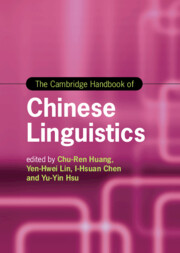Book contents
- The Cambridge Handbook of Chinese Linguistics
- Cambridge Handbooks In Language and Linguistics
- The Cambridge Handbook of Chinese Linguistics
- Copyright page
- Contents
- Figures
- Tables
- Contributors
- Acknowledgments
- Part One Writing System/Neuro-cognitive Processing of Chinese
- Part Two Morpho-lexical Issues in Chinese
- Part Three Phonetic-phonological Issues in Chinese
- Part Four Syntax-semantics, Pragmatics, and Discourse Issues
- 19 SVO as the Canonical Word Order in Modern Chinese
- 20 SOV as the Canonical Word Order in Modern Chinese
- 21 Semantic and Pragmatic Conditions on Word Order Variation in Chinese
- 22 The Case for Case in Chinese
- 23 The Case without Case in Chinese
- 24 The Syntax of Classifiers in Mandarin Chinese
- 25 The Chinese Classifier System as a Lexical-semantic System
- 26 Syntax of Sentence-final Particles in Chinese
- 27 Sentence-final Particles
- 28 Topicalization Defined by Syntax
- 29 An Interactive Perspective on Topic Constructions in Mandarin
- 30 Grammatical Acceptability in Mandarin Chinese
- Index
- References
25 - The Chinese Classifier System as a Lexical-semantic System
from Part Four - Syntax-semantics, Pragmatics, and Discourse Issues
Published online by Cambridge University Press: 04 August 2022
- The Cambridge Handbook of Chinese Linguistics
- Cambridge Handbooks In Language and Linguistics
- The Cambridge Handbook of Chinese Linguistics
- Copyright page
- Contents
- Figures
- Tables
- Contributors
- Acknowledgments
- Part One Writing System/Neuro-cognitive Processing of Chinese
- Part Two Morpho-lexical Issues in Chinese
- Part Three Phonetic-phonological Issues in Chinese
- Part Four Syntax-semantics, Pragmatics, and Discourse Issues
- 19 SVO as the Canonical Word Order in Modern Chinese
- 20 SOV as the Canonical Word Order in Modern Chinese
- 21 Semantic and Pragmatic Conditions on Word Order Variation in Chinese
- 22 The Case for Case in Chinese
- 23 The Case without Case in Chinese
- 24 The Syntax of Classifiers in Mandarin Chinese
- 25 The Chinese Classifier System as a Lexical-semantic System
- 26 Syntax of Sentence-final Particles in Chinese
- 27 Sentence-final Particles
- 28 Topicalization Defined by Syntax
- 29 An Interactive Perspective on Topic Constructions in Mandarin
- 30 Grammatical Acceptability in Mandarin Chinese
- Index
- References
Summary
This chapter shows that treating the Chinese classifier system as a lexicalized semantic system based on shared ontology predicts both the agreement patterns that motivate the structure-based accounts, and the semantic selection patterns that motivate the cognition-based accounts. In the chapter, different perspectives toward classifiers are introduced including a cognition-based account (predicting a strong correlation with perception that is also robust and without exceptions but allows some fuzzy, overlapping classifications) and a structure-based account (predicting a strongly binary classification and a robust grammaticality judgement). Controversial issues regarding Chinese classifiers, such as the distinction between classifiers and measure words, the agreement between a classifier and its head noun, and the nature of 的 DE insertion, are explicated to show the pros and cons of various approaches. The authors demonstrate that Chinese classifiers are coherently organized in a ontology-driven lexical-semantic system. Major unresolved issues in the Mandarin classifiers system are closely examined at the end of the chapter.
Keywords
- Type
- Chapter
- Information
- The Cambridge Handbook of Chinese Linguistics , pp. 550 - 577Publisher: Cambridge University PressPrint publication year: 2022



